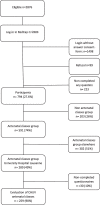What do mothers think about their antenatal classes? A mixed-method study in Switzerland
- PMID: 37858110
- PMCID: PMC10585766
- DOI: 10.1186/s12884-023-06049-8
What do mothers think about their antenatal classes? A mixed-method study in Switzerland
Abstract
Problem: Research so far has evaluated the effect of antenatal classes, but few studies have investigated its usefulness from the perspective of mothers after birth.
Background: Antenatal classes evolved from pain management to a mother-centred approach, including birth plans and parenting education. Evaluating the perception of the usefulness of these classes is important to meet mother's needs. However, so far, research on the mothers' perception of the usefulness of these classes is sparse, particularly when measured after childbirth. Given that antenatal classes are considered as adult education, it is necessary to carry out this evaluation after mothers have had an opportunity to apply some of the competences they acquired during the antenatal classes during their childbirth.
Aim: This study investigated mothers' satisfaction and perceived usefulness of antenatal classes provided within a university hospital in Switzerland, as assessed in the postpartum period.
Methods: Primiparous mothers who gave birth at a Swiss university hospital from January 2018 to September 2020 were contacted. Those who had attended the hospital's antenatal classes were invited to complete a questionnaire consisting of a quantitative and qualitative part about usefulness and satisfaction about antenatal classes. Quantitative data were analysed using both descriptive and inferential statistics. Qualitative data were analysed using thematic analysis.
Findings: Among the 259 mothers who answered, 61% (n = 158) were globally satisfied with the antenatal classes and 56.2% (n = 145) found the sessions useful in general. However, looking at the utility score of each theme, none of them achieved a score of usefulness above 44%. The timing of some of these sessions was questioned. Some mothers regretted the lack of accurate information, especially on labour complications and postnatal care.
Discussion: Antenatal classes were valued for their peer support. However, in their salutogenic vision of empowerment, they did not address the complications of childbirth, even though this was what some mothers needed. Furthermore, these classes could also be more oriented towards the postpartum period, as requested by some mothers.
Conclusion: Revising antenatal classes to fit mothers' needs could lead to greater satisfaction and thus a better impact on the well-being of mothers and their families.
Keywords: Delivery; Maternal health services; Obstetric; Patient satisfaction; Pregnant mothers; Prenatal education.
© 2023. BioMed Central Ltd., part of Springer Nature.
Conflict of interest statement
The authors declare no competing interests.
Figures
References
-
- Blanchard-Freund E, Guillaume,S. De la psychoprophylaxie de l'accouchement à la préparation à la naissance et à la parentalité. EMC (Elsevier Masson, SAS, Paris), Obstétrique. 2008;3(3):1–10.
-
- Vuille M. L’obstétrique sous influence: émergence de l’accouchement sans douleur en France et en Suisse dans les années 1950. Revue d'histoire moderne et contemporaine. 2017;64–1(1):116–49.
-
- Bergström M, Kieler H, Waldenström U. Effects of natural childbirth preparation versus standard antenatal education on epidural rates, experience of childbirth and parental stress in mothers and fathers: a randomised controlled multicentre trial. BJOG. 2009;116(9):1167–1176. doi: 10.1111/j.1471-0528.2009.02144.x. - DOI - PMC - PubMed
-
- Maffi I. Les cours de préparation à la naissance dans une maternité suisse. Entre logiques institutionnelles, postures des sages-femmes et autonomie des couples. Accompagner la naissance. Bangkok %J A contrario Campus: BSN Press; 2014. pp. 175–98.
MeSH terms
LinkOut - more resources
Full Text Sources
Medical




